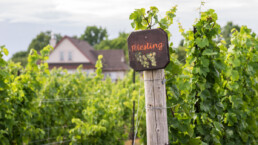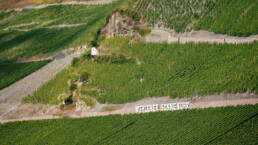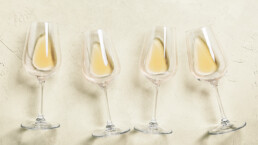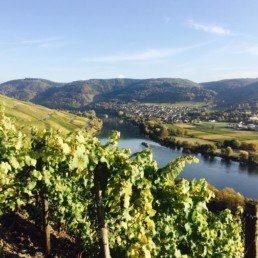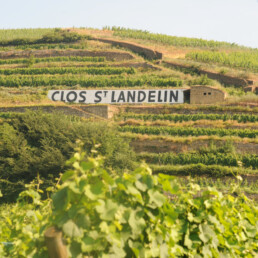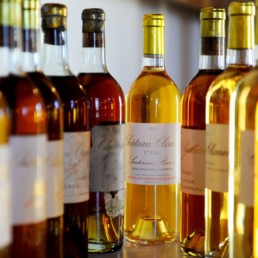Riesling, for some unknown reason, is the “Cinderella” of the white wine world. Going unnoticed and unloved by the greater public as they clamour for more savvy and more chardy. Yet, it is almost universally adored by winemakers and wine geeks the world over. Riesling has been responsible for life-changing epiphanies for so many in the wine community. So how does a seemingly vapid “sweet” white wine capture the hearts and minds of serious wine enthusiasts?
Here at D&N we know that, deep down, Riesling wants to become fashionable and sophisticated in the eyes of non-wine-geeks so we’re being the Fairy Godmother for Cinderella Riesling by doing our first “Focus On” blog about the wine we geeks adore!
Riesling isn’t simply loved, it’s worshipped.
To know riesling is to love riesling.
At its best, Riesling is a wine of extremes. It is a charismatic chameleon that has so much more to offer than just sweetness. Like Semillon, Riesling can produce impeccable, long-lived wines with intense aromatic qualities that range in style from bone dry to lushly sweet dessert wines. Unlike many other white wines, Riesling can be high in fruit with refreshing acidity and low alcohol to balance it all to sublime vinous perfection.
Renowned wine critic Jancis Robinson calls it one of her “great wine heroes” and says, “This is the wine to drink while writing or reading; it refreshes the palate and sharpens the brain.”
Here are four great reasons to love Riesling:
Terroir Transparency:
Possibly the greatest facet of Riesling is its ability to express site-specific characteristics from the vineyard or region it is grown in – it’s probably better at this than any other grape variety. For example, where Rieslings are made in exactly the same way by the same producer from two vineyards with different soils or aspects they will usually show corresponding differences in flavour profile.
Ageability:
Riesling shows an amazing capacity to age. Even relatively inexpensive Kabinett and Spatlese wines from Germany develop gracefully for many years. So as a white wine with usually no oak barrels or tannins in sight, it is thanks to Riesling’s high level of acidity, that acts as a natural preservative of the wine that enables it to age gracefully over time. The best Rieslings have been known to cellar for decades or longer. Over time, a Riesling will often darken in colour from a pale straw to a more golden hue. The original fruit forward flavours will soften and be replaced by more subtle and complex characters and aromas. Often an aged Riesling will have a distinctive petrol note to it, some consider this a flaw but many more treasure it as a sign of maturity (more on this later).
Versatility:
Riesling can be made in an astonishing variety of styles. That’s what makes it so great; there is a style of Riesling for every palate. One characteristic uniting all Riesling is the grape’s super high acidity. Beyond that, Riesling can be light or full, dry or sweet, delicate or powerful, with wonderful flavours and with subtle textures. This easy-to-love white wine pairs well with a range of foods, offering a nice counterpoint to spicy food. Riesling also has a low-to-average amount of alcohol, depending on the style.
Value:
Great examples of Riesling are never going to be cheap. But compare the prices for the best Rieslings with the current prices of other fine wines, and they are remarkably affordable, no doubt because of their (unexplainable) relative “unpopularity”.
Brandon Nash’s Top 6 Dhall & Nash Riesling Picks…
At D&N one of our favourite aspects of Riesling is the wide stylistic range of wines that can be produced and enjoyed for different reasons. From complex, dry, age-worthy bottles to the sumptuous exotics of dessert wines. That makes it darn difficult to select our Riesling faves when we have over 20 in our portfolio. So, we put the pressure on our own Brandon Nash to make the big 6 selection!
2013 Foxes Island Belsham Awatere Estate Dry Riesling
Foxes Island is one of the only New Zealand wineries who cellar age their wines, patiently waiting for the transformation of flavours, complexity and structure to develop in bottle before releasing to market. This dry Riesling is a perfect example of this ambitious and talented Estate run by John Belsham, and is utterly delicious.
2013 Mountford Estate Liaison Riesling
Mountford Estate are famous for Chardonnay and Pinot Noir, yet their Liaison Riesling is one of our top selling wines in the Dhall & Nash portfolio. A perfect balance of ripeness, sweetness, and acidity with bottle aged complexity.
2013 Domaine Rene Muré Clos St Landelin Riesling
A famous plot in the Grand Cru vineyard of Vorbourg in southern Alsace from the great Domain Rene Muré – an opulent and powerful style, showing richness, size and dimension on the palate.
2019 Schloss Lieser Niederberg Helden Riesling Trocken GG
One of the finest Estates in the Mosel, Schloss Lieser produce an array of Riesling styles from dry to sweet. This wine is their flagship Grosses Gewachs and an icon in Germany. Simply put, the best dry Riesling from the best vineyard in the Mosel.
2019 Schloss Lieser Wehlener Sonnenuhr Riesling Auslese Goldkapsel
The pinnacle of sweet Riesling from the famous blue slate Sonnenuhr vineyard in Wehlen in the Mosel. If you think you are not sure what minerality is, you will know once you taste this wine.
2019 Schloss Lieser Wehlener Sonnenuhr Riesling GG
Schloss Lieser is one of the few privileged owners of land in this precious part of the Mosel, a famous south to south west facing slope of blue slate soil. Small bunches of Riesling grapes are left to ripen on the vine late into harvest and then naturally fermented to bone dry on fine lees for almost a year before bottling. The result, a stunning, powerful and radiant expression of Dry Riesling that nowhere else on earth can produce.
Family background of Riesling:
The history of Riesling is murky, but ampelography research points to the Rhine River region in Germany/Alsace as the birthplace of Riesling. The grape is a natural derivative of Gouais Blanc, an esoteric French grape that is grandmother to many of today’s most well-known wines, including Chardonnay, Riesling, Petit Verdot, Chenin Blanc, and Muscadelle. The first recorded mention of Riesling appeared in the 1435 sale of several Riesling vines to a German Count. Green grapes in general, and Riesling in particular, grew steadily in popularity until 1787, when the Archbishop of Trier ordered that all bad vines be replaced with Riesling varietals. By the 1850s, Riesling had become a fashionable and sought-after wine, commanding higher prices than Bordeaux and Champagne. This continued into the early 20th century where German Rieslings were particularly highly prized and equally highly priced. So why have modern day consumers neglected to embrace this vinous darling of wine nerds?
“Great Riesling is like a very large orchestra playing very quietly.” – Helmut Dönnhoff, Superstar German Winemaker
Getting to Know Riesling’s Sweet Side:
The elephant in the Riesling room is sweetness. In the 60’s and 70’s the name Riesling was applied to a wide range of white grape varieties of dubious quality that were often sold in bulk ‘chateau cardboard’ packaging. This was the ultimate ‘backhanded compliment’ given to Cinderella Riesling! Yes, many Rieslings are sweet, both at the high and low ends of the market, and by no means is that a bad thing. At its best, Riesling displays racy minerality, rich texture, complex fruit, and – of course – sweetness. Sadly, this often leads to a wine being dismissed entirely and without good reason. It is not the sweetness that’s the problem, it’s the balance! And Riesling’s double delights are its intense perfume and its piercing crisp acidity which offset the cloying effect of residual sugar in well-crafted wines.
Additionally, sugar in wine contributes to longevity in the cellar, so it’s no coincidence that some of the most expensive, age worthy Riesling is sweet. Sweet, late-harvest styles like Spätlese, Auslese, and Eiswein can only be made from the most select grapes which can withstand the extra ripening time without attracting bad rot. Then, due to the evaporation of water as the grape shrivels (and freezes in the case of Eiswein), the grapes yield less juice, thus adding to their rarity and value. Many a Mosel kabinett has residual sugar, but in conjunction with typically high levels of acid, the experience is tempered into a dynamic sweet-and-sour wine.
Old World vs New World Rieslings:
While historically associated with Germany, Riesling’s receptivity to a range of cooler growing conditions and even poor soils has made it a natural choice for international plantings. Germany’s Mosel, Rheingau, Rheinhessen, and Pfalz regions are the traditional Riesling heartland, but diverse styles also prevail in Alsace, France, and Austria in the Old World. Whilst in the New World, Australia’s Clare and Eden Valleys as well as California, Washington State, and New York State also grow a considerable amount of top-quality Riesling.
Maybe it is thanks to the New World that Riesling is starting to enjoy the sparks of a renaissance. In Australia, the grape has developed a formidable reputation, delivering lime-sherbet fireworks amid the continental climate of Clare Valley, north of Adelaide, while Barossa’s Eden Valley is cooler still, producing restrained stony, lime examples from the elevated granitic landscape; Tasmania is fast becoming their third Riesling terroir, combining cool temperatures with high UV levels to deliver stunning styles.
Here in New Zealand Riesling is perfectly suited to Central Otago, with its granitic soils and continental climate, also to North Canterbury, Marlborough, and the pebbly Brightwater area near Nelson. Although there are no fixed stylistic formulae for Riesling in New Zealand, this is far from being a bad thing. Here we are blessed in having the potential to produce a broad range of Riesling styles. It’s a bit like having all the producing regions of Germany, France, and Australia under one sky.
“Time and again, New Zealand Riesling proved to be an amazingly consistent, pure and refreshing expression of a great grape, irrespective of producer.” – James Laube, Wine Spectator
Taste and Flavour Profile:
In Karen MacNeil’s “Wine Bible” she aptly writes, “On the palate, Riesling is meant to move — to shimmer; to surge, to burst, to dance, to arc, to soar. Riesling has a rare trait – velocity. Of all varietals, it is the most kinetic and alive.”
Without doubt, wherever Riesling wine is produced, it is known for its powerful, rapier-like aromas and distinctive flavours. Variously described as flowery, delicate, racy, pure, limey, pithy, steely, nervy, invigorating, zesty, tangy, electric, lively, crisp, incisive, focused, ethereal, minerally, crystalline, stony, honeyed, waxy, sherbet, sweet-sour, tense, tongue-tingling, and much more!
Riesling is all about tension and balance. Walking a tightrope of fruit sweetness and acidity, Riesling can be made as a rich, fruit-filled style with residual sugar, or with a crisp, nervy nature that jumps about on the palate. Further taste and texture interest is provided from the mineral elements which are usually a reflection of the terroir. Meanwhile, the Riesling olfactory calling card is the infamous wafts of petroleum or kerosene that can sometimes be detected. This is produced by a natural chemical compound called TDN (we’ll get into this a bit later in geek talk).
Food and Riesling:
Fitting wine with food or occasion can become an overthought or even a laboured subject for some wine drinkers. This is where Riesling comes in. So, why will Riesling do the job on just about anything you throw at it? Firstly, the acidity adds freshness and makes your mouth water – perfect when you’re about to eat. Secondly, little to no oak to overpower more delicate dishes. Thirdly, the varying levels of sweetness – from bone dry to super sweet make it the most versatile grape around to match with numerous dishes, desserts, or cheeses!
Wine Geek Talk, Part 1 – "That" Aroma:
In some Riesling wines there is a striking ‘petrol’ or ‘kerosene’ note. While an integral part of the aroma profile of mature Riesling and sought after by many experienced drinkers, it may be off-putting to those unaccustomed to it, and those who primarily seek young and fruity aromas in their wine.
This distinct ‘petrol’ type aroma is caused by the compound 1,1,6-trimethyl-1,2-dihydronaphthalene or ‘TDN’ for short. If the wine has high acidity, levels of TDN are more likely to increase over time. Also, interestingly, corks absorb much of the TDN, so a screw cap Riesling will often show much more of this trait upon opening.
Various studies have determined that there are some factors that are likely to increase the TDN potential in Rieslings. These could be: ripe grapes, i.e., low yields and late harvest; high sun exposure; water stress, which is most likely in regions which do not practice irrigation, and high acid content. These factors are usually also considered to contribute to high quality Riesling wines, so the petrol note is in fact more likely to develop in top wines than in simpler wines made from high-yielding vineyards, especially those from the New World, where irrigation is common.
Wine Geek Talk, Part 2 – German Riesling Classifications:
Kabinett: Grapes picked during normal harvest, yielding a light bodied, low alcohol wine that’s normally dry or off-dry.
Spätlese: Means “late harvest”. Fully ripe grapes bring more fruit intensity and a fuller body. These wines can be dry or off-dry, and the subtle sweetness is often offset by the sharp acidity.
Auslese: Means “select harvest”. Made in the best years from carefully chosen fully ripe grapes. These wines are lush and fairly sweet.
Beerenauslese: Literally translated means “berry selected harvest”, this wine is made from very ripe hand-harvested grapes affected by noble rot, and only in great vintages. Very sweet.
Trockenbeerenauslese: The richest, sweetest, most expensive of all German wines. Only made in exceptional years.
Eiswein: Literally “ice wine” and made from frozen grapes. They are crushed, and the ice separated from the juice, resulting in a very sweet, highly acidic dessert wine.
Grosses Gewächs or GG: The term GG is used to identify some of the finest white wines of Germany and is specific to dry (Trocken) wines. All the Grosses Gewächs wines come from a Grosses Lage (‘great site’), that is, from the best vineyard sites.
Producers that make wines with a GG distinction must be one of the 200 members of the Verband Deutscher Pradikatsweinguter, or VDP. It may sound like some sort of secret organisation, but the VDP is a German wine group representing the country’s top producers. They have an uncompromising dedication to high quality wines and as such, they produce a disproportionately large proportion of Germany’s top wines. Like the grand crus of Burgundy, these wines take the name of the vineyard and not the village. Unlike their French counterparts, the term does not exist within any part of German wine law. The GG wines can be recognised by a stylized symbol of an eagle and grapes that adorns all VDP members’ bottles.
Further, the VDP created a four-level vineyard classification system that closely resembles that of Burgundy: Grosses Lage = Grand Cru, Erste Lage = Premier Cru, Ortswein = Village Wine, Gutswein = Basic wine from a lower quality vineyard.
To make the GG grade, yields must not exceed 50 hectolitres per hectare, and the grapes must be physiologically, fully ripe, and be hand harvested. These wines are released on the 1st September of the year after harvest. Vinification must be done in the traditional way. In short, stringent rules to protect Germany’s wine culture and reputation.
Enough of the geek talk. More importantly, have we converted you to worship at the Chapel of Riesling? Hopefully by now we have dispelled the old assumption that all sweet Riesling wines are naff and unsophisticated. Riesling can be as gastronomic or as laid back as you like, representing some of the best values and the most rarefied cellar choices on the market.
In the wake of all our years of Riesling devotion, we can’t help but toast to the delicious complexity and multiplicity of Riesling. There is something undeniably appealing about its ability to hold counterpoints harmoniously in a single glass: of sweetness alongside tartness, of stony minerals mingling delectably with flowers and fruit. It offers delightful surprises even to the most seasoned veterans and ages gracefully for decades. Given this magical mojo, how could you not be at least a little bit better for the sipping of it?
Time for Cinderella Riesling to re-claim her crown.
Here below is the full Dhall & Nash range of Rieslings from around the world:
2013 Domaine Rene Muré Clos Saint Landelin Riesling
2016 Domaine Rene Muré Calcaires Jaunes Riesling
2018 Domaine Rene Muré Calcaires Jaunes Riesling
2018 Schloss Lieser Riesling Feinherb
2019 Schloss Lieser Niederberg Helden Riesling Spatlese
2019 Schloss Lieser Niederberg Helden Riesling Trocken GG
2019 Schloss Lieser Niederberg Helden Riesling Trocken GG 375ml
2019 Schloss Lieser Wehlener Sonnenuhr Riesling Auslese Lange Goldkapsel 375ml
2019 Schloss Lieser Wehlener Sonnenuhr Riesling GG
2019 Schloss Lieser Wehlener Sonnenuhr Riesling GG 1.5L
2016 Fritz Ekkehard Huff Schwabsburger Riesling
2013 Foxes Island Belsham Awatere Estate Dry Riesling
2015 Foxes Island Icon Series Noble Riesling 375ml
2018 FOX by John Belsham Ma Chérie Late Harvest Riesling
2013 Mountford Estate Liaison Riesling
2018 Aurum Dry Riesling
2019 Aurum Dry Riesling
2019 Hawkshead Riesling
2019 Johner Estate Wairarapa Riesling
2020 Johner Estate Wairarapa Riesling Light
2014 Kalex Riesling
2017 Grosset Springvale Riesling
2016 Norman Hardie Niagara Riesling
NV Barefoot Riesling
